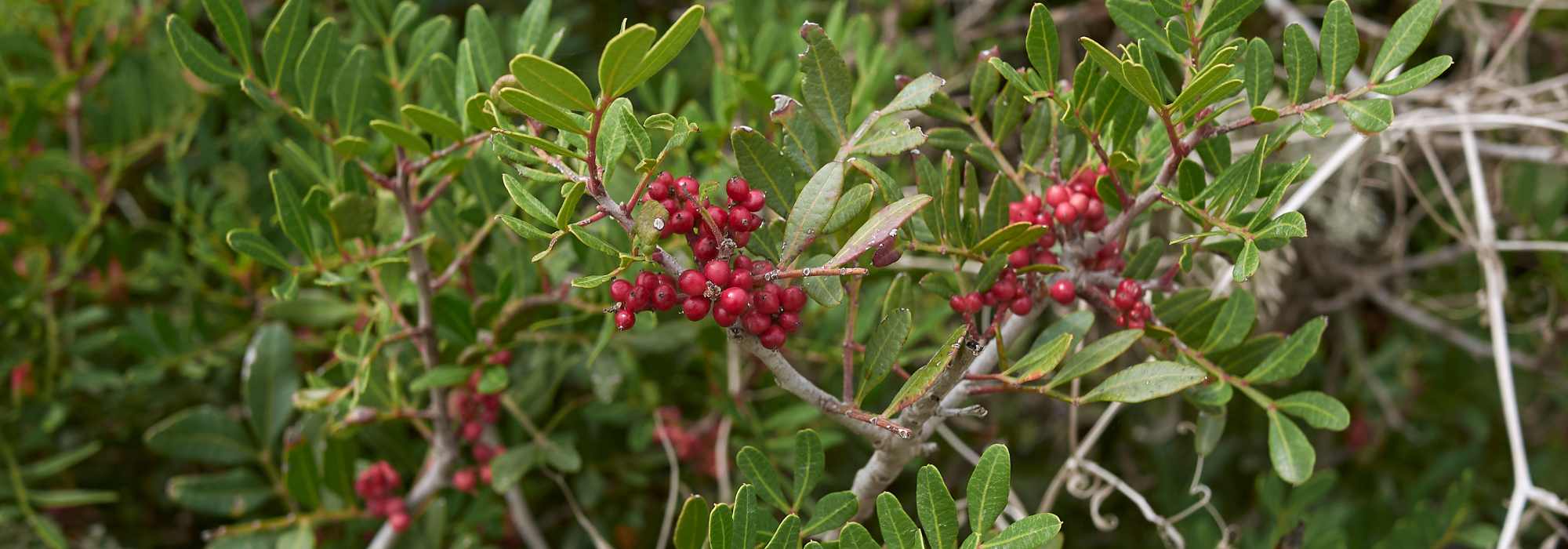
Pistachio Tree, Pistacia : Planting and Care
Contents
The pistachio tree in a nutshell
- It is grown as much for its fruits as for its ornamental qualities
- Depending on the species, its foliage is deciduous or evergreen
- In our climate, it is difficult to obtain fruits; it will be mainly decorative
- It needs sun, well-drained and preferably alkaline soil
- Hardy, it is nevertheless best planted in the ground in mild climates
The word from our expert
The pistachio or Pistacia in Latin, is a beautiful evergreen or deciduous bush known for the fruits it produces: pistachios, those dried fruits we snack on during aperitifs! While only one species yields pistachios, the true pistachio (Pistacia vera), the others are highly ornamental. Although pistachios are hard to obtain in our climate, the lovely foliage and decorative fruiting of the pistachio bush deserve our full attention, like the mastic tree, which produces numerous small fruits that are as edible as they are decorative.
Particularly suited to Mediterranean and oceanic climates, the pistachio bush is not difficult to cultivate as long as the right conditions are met. Although hardy, it is best planted in coastal gardens spared from severe frosts, in light, well-draining, preferably alkaline soil. This bush is very well adapted to drought and summer heat. It requires little maintenance and tolerates light pruning well, which will help it remain bushy and suitable for hedging. Discover this tree, both fruitful and ornamental!
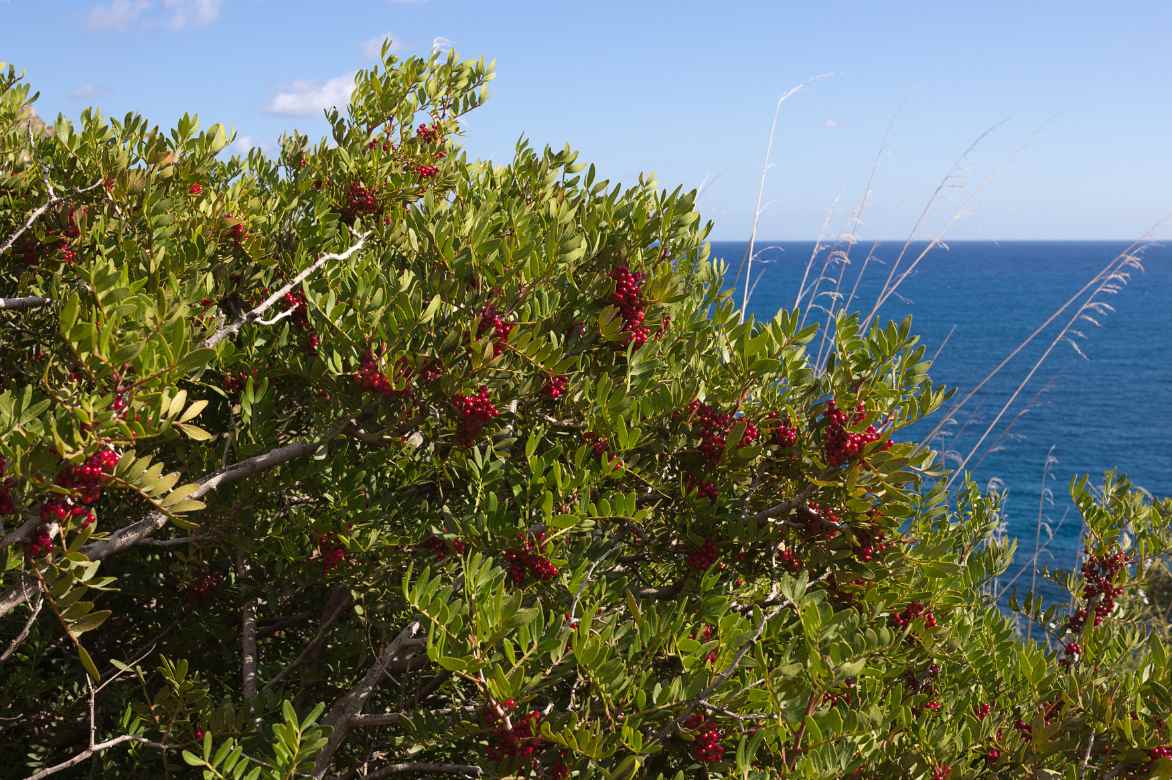
Pistacia lentiscus growing wild in the Mediterranean
Description and Botany
Botanical data
- Latin name Pistacia
- Family Anacardiaceae
- Common name Mastic tree, true pistachio
- Flowering March to May
- Height 2 to 10 m
- Exposure Sun, partial shade
- Soil type Light, dry, well-drained
- Hardiness -12°C and beyond
The Pistacia, also known as the pistachio tree, is a bush from the Anacardiaceae family, like the cashew nut and mango trees. It is sometimes considered to belong to a separate family, the Pistaciaceae. This bush originates from temperate to tropical regions around the world, mainly in Asia and around the Mediterranean basin, as far as Israel. The genus Pistacia includes around 15 deciduous or evergreen species. Among them, we distinguish ornamental pistachio species from fruit-bearing pistachio trees like the Pistacia vera, the true pistachio, which is the only one that produces the famous pistachios. The latter only fruits properly in regions with long, hot summers and will thrive only in the south of France. Do not confuse the pistachio tree with the Staphylea pinnata, also called the false pistachio due to its edible seeds that resemble pistachios. Between the true pistachio and the false pistachio, it can be quite confusing!
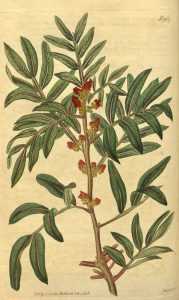
Pistacia lentiscus, illustration (1818)
Alongside the fruit-bearing pistachio, there are also ornamental species of pistachio trees:
- The Pistacia terebinthus, the terebinth pistachio, is a deciduous species and one of the hardiest. Its bark exudes a resin (which gave its name to turpentine). This species also produces numerous clusters of small red fruits that are edible but not very tasty.
- The Pistacia chinensis, the Chinese pistachio, is the hardiest (-20°C). Its deciduous foliage turns red before falling in autumn.
- The Pistacia lentiscus, the mastic tree or lentisk pistachio, is a small tree native to our region. It is spontaneous in the Corsican scrub vegetation, around the Mediterranean, and as far as Charente-Maritime. It also produces an aromatic resin with many properties and small edible fruits.
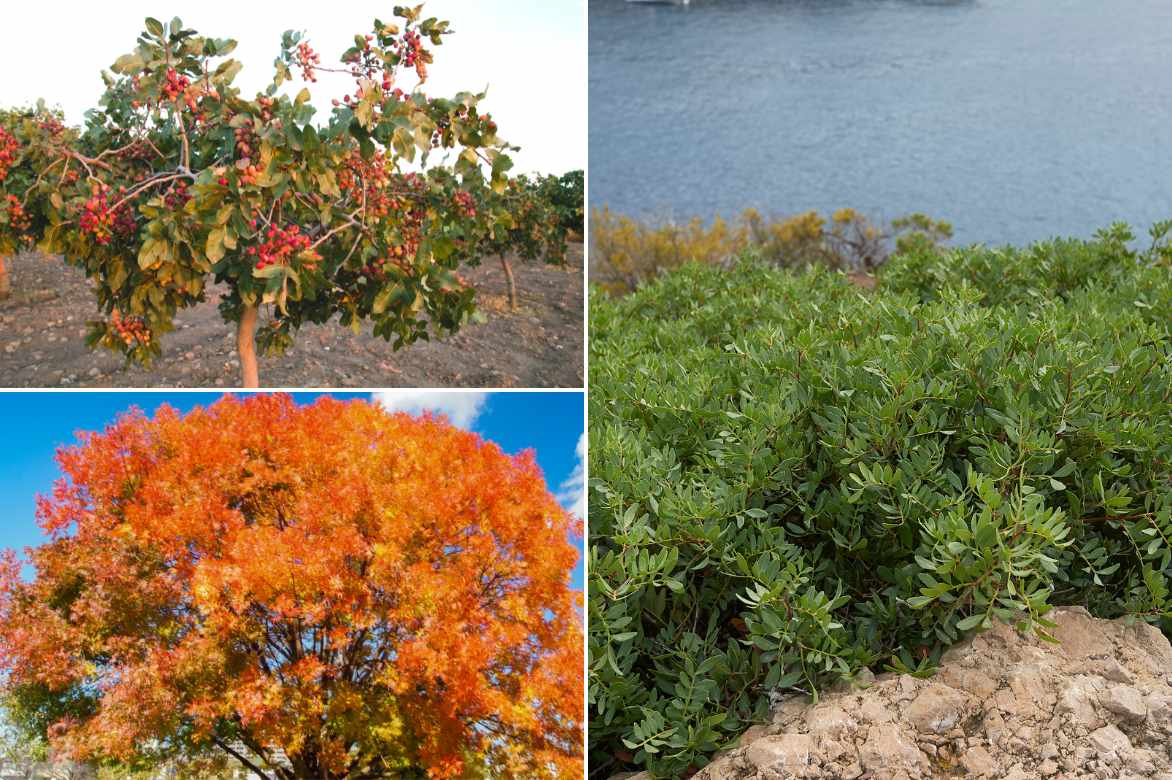
Pistacia vera top left, Pistacia chinensis bottom left, and Pistacia lentiscus right
The pistachio tree forms a small tree with a bushy, rounded habit, measuring between 2 and 10 m in height, depending on the species. Its growth is relatively slow. Pistachio trees display great longevity and can live for over 100 years.
It is a rather polymorphic tree or bush, generally wider than tall, and when planted in windy areas, it may adopt a more creeping habit. Its elegant branches are highly ramified. The foliage is deciduous or evergreen, depending on the species. It consists of alternate, petiolate leaves, imparipinnate in shape, divided into 4 to 14 small ovate or elliptical-lanceolate leaflets, glossy and leathery. They can measure up to 20 cm in length. Their colour is a bright green, sometimes taking on reddish to purplish hues under the effect of cold. They have prominent veins. The evergreen leaves of the Pistacia lentiscus resemble those of the Viburnum tinus or Laurustinus.
The Pistacia lentiscus and Pistacia terebinthus emit a powerful balsamic scent from the amber resin that escapes from their grey-orange bark. They exude a resin that hardens in contact with the air, called mastic in one (the renowned lentisk resin) and turpentine in the other. The most sought-after mastic comes from lentisks native to the Greek island of Chios. It has antiseptic properties and is also used in the manufacture of dental amalgams, confectionery, alcoholic beverages, pharmacology, and perfumery.
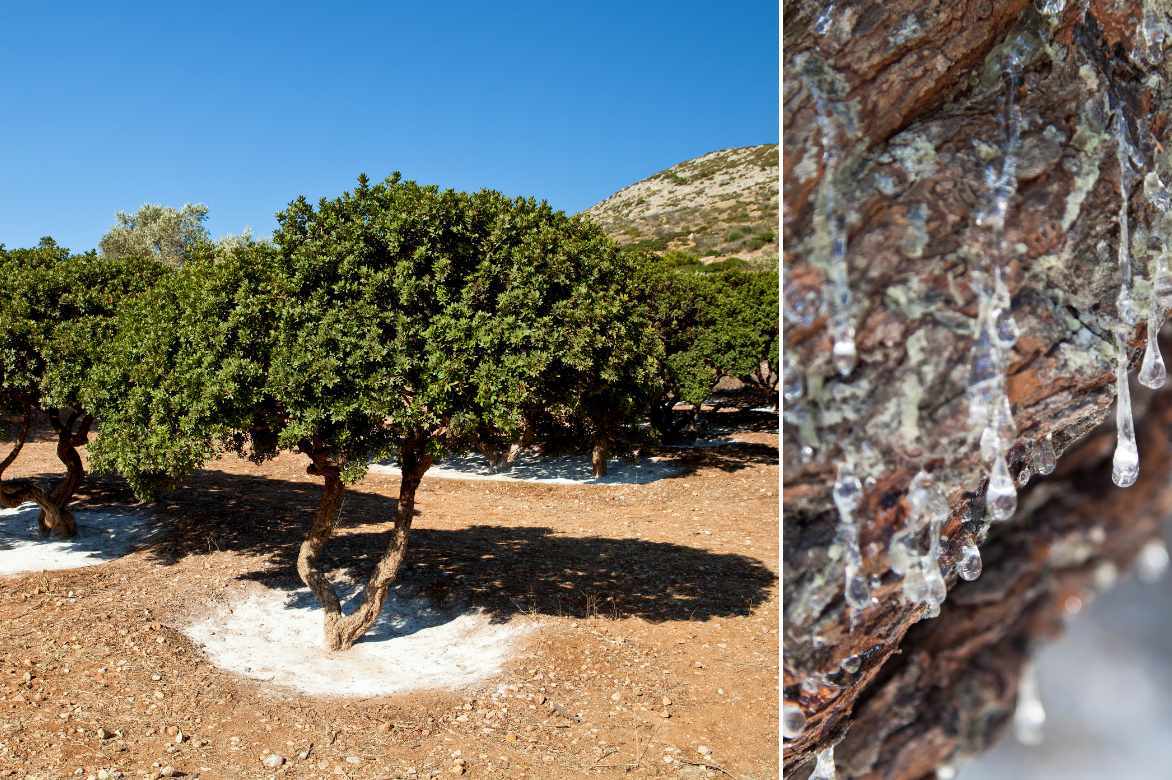
Mastic tree on the island of Chios in Greece, where the mastic that flows from the trunks is harvested
Flowering occurs from March to May. It appears as panicles of rather insignificant yellowish-green flowers. The pistachio tree is dioecious, meaning there are male and female trees, and it is necessary to have one of each sex to obtain fruits (1 male for 5 females).
Fruiting varies from one species to another, and pollination from male trees to female trees is difficult in our climates. When the tree fruits, this flowering is followed by numerous small edible fruits. Fruiting of the true pistachio only occurs in warm regions and after 7 years of cultivation. In the true pistachio, the fruit is a drupe containing a shell that encloses an edible almond with a purple skin and green flesh: the pistachio, which is then dried to be consumed as a dried fruit, as an appetiser, but also in pastries and confectionery. The Pistacia lentiscus and terebinthus also produce small edible drupes. They are grouped in clusters of small fruits the size of a pea, first red then black at maturity. They contain a small almond-shaped seed with a slightly sour and refreshing flavour. They can be eaten raw or pickled like capers.
The hard wood of the pistachio tree is used in marquetry, cabinetmaking, and carpentry.
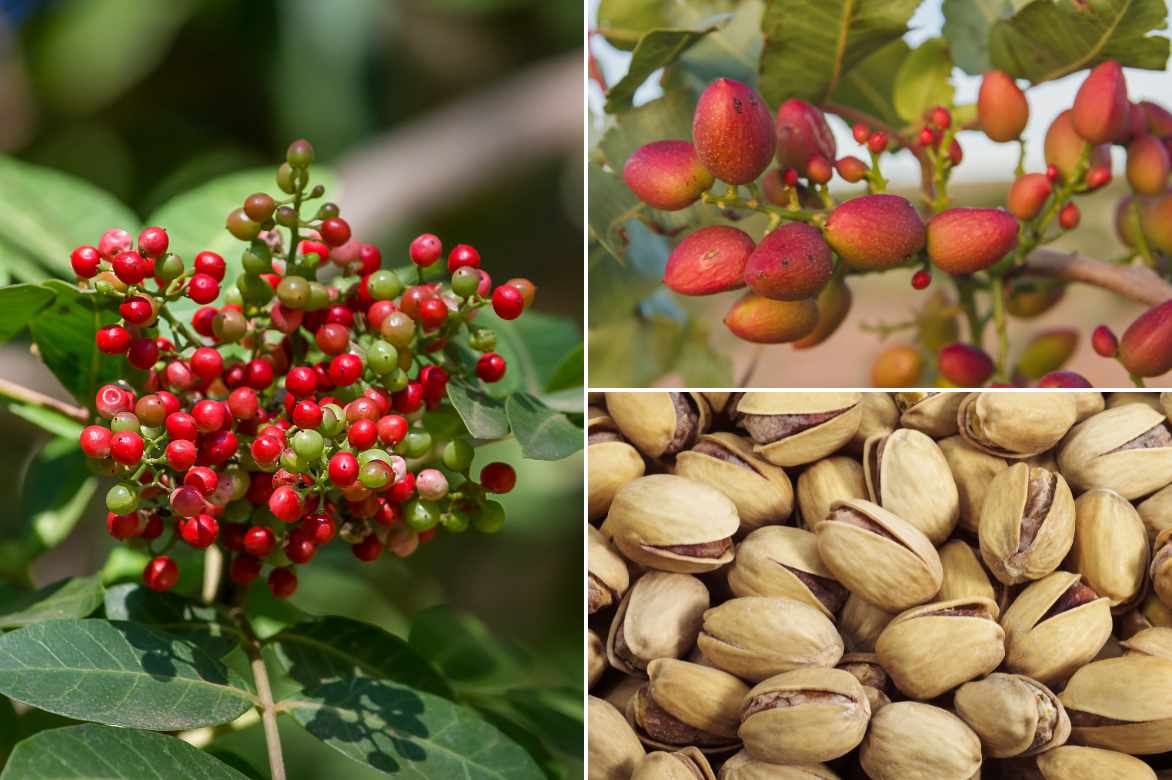
Fruits of Pistacia lentiscus on the left, and on the right, fruits on the Pistacia vera tree, which produces the pistachios we enjoy
Main species and varieties
[product sku=”83438″ blog_description=”An evergreen species with beautiful foliage and lovely fruiting. This pistachio tree is also known for its highly aromatic amber resin. Essential for creating the evergreen structure of the garden in a mild climate.” template=”listing1″ /]
Planting the Pistachio Tree
Where to Plant It?
Native to the Mediterranean basin or the Middle East, the Pistacia thrives in warm climates and tolerates drought. It is a relatively frost-sensitive tree, preferring regions with mild winters. This is why it is mainly cultivated on the French Riviera. Some species, such as the mastic tree, can withstand short frosts of around -12/-15°C once well-established, in well-drained soil and sheltered from prevailing cold winds. Note that north of the Loire, the pistachio tree has little chance of fruiting.
While the tree itself is not afraid of the cold, its flowering is at risk of being destroyed by late frosts. In open ground, it is best suited to Mediterranean climates with dry, hot summers, with evergreen species being particularly well-adapted to summer heat and drought. And since it also tolerates sea spray, it can be planted without hesitation near the coast.
Undemanding in terms of soil and exposure, it thrives in all types of soil. It can grow in poor, rocky, arid, or slightly acidic soil, though it prefers well-drained, calcareous soils. Choose a warm, sunny spot, though it also tolerates partial shade.
The pistachio tree can be planted in dry gardens with a Mediterranean inspiration, in a shrub border, or even in a hedge in mild climates, as its fruiting is highly decorative.
When to Plant It?
In regions with mild climates, the pistachio tree is best planted in early autumn, in September-October. In areas near its hardiness limit, opt for spring planting.
How to Plant It?
The pistachio tree prefers well-drained soil. Allow a spacing of 7-10 metres between two trees.
- Loosen the soil deeply
- Soak the root ball for 1 hour in a bucket of water
- Dig a large hole at least 30 cm deep in all directions
- Spread pumice, river sand, or gravel at the bottom of the planting hole
- Place the bush in the centre of the hole with a stake
- Keep the pistachio tree upright and fill the hole with compost and sand mixed with the excavated soil, without burying the collar
- Firm the soil with your foot
- Water generously after planting
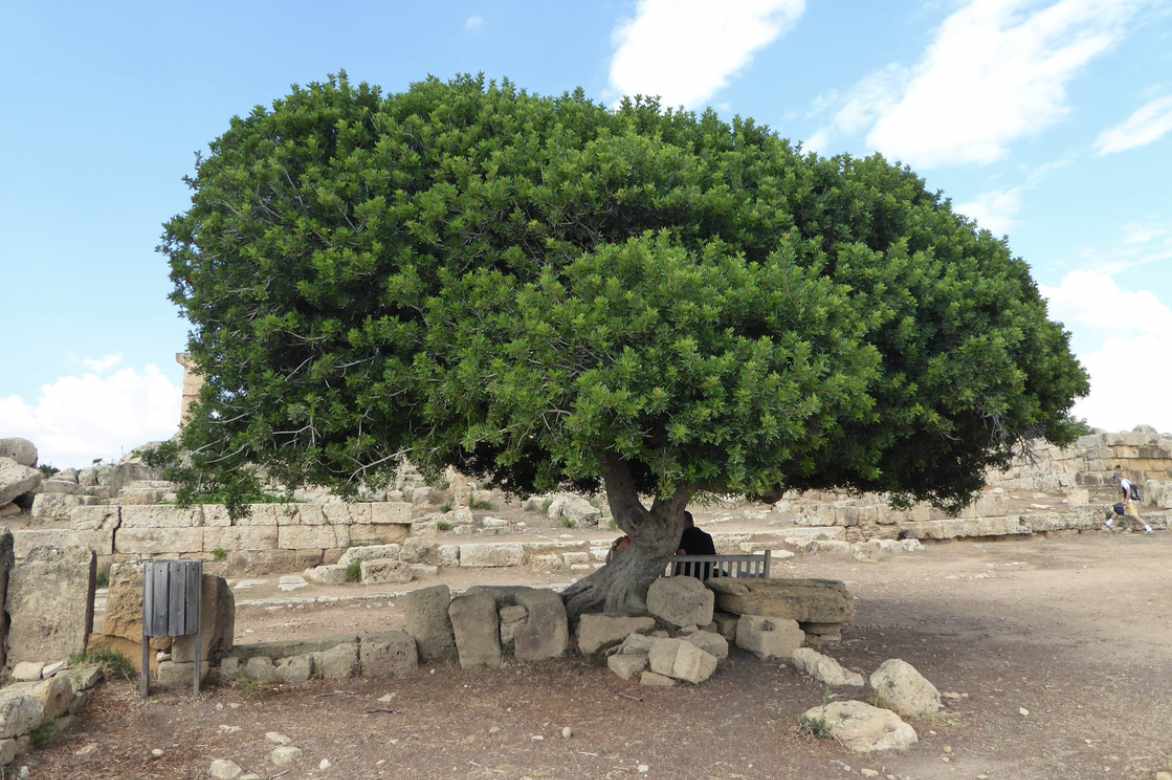
A venerable mastic tree on the site of Selinunte in Sicily (© Gwenaëlle David Authier)
Maintenance, pruning and care
The Pistacia is easy to cultivate in privileged regions where frost is neither severe nor prolonged. It only fears cold winters, especially when young. Once well-established, it will become increasingly drought-resistant. However, even though the pistachio tree is particularly drought-resistant, it needs regular watering during its growth period, especially to produce pistachios. In summer, be vigilant for the first 2-3 years after planting, watering as soon as the soil is dry without ever waterlogging it.
In autumn, apply compost around the base of the bush by lightly scratching the soil. Regularly hoe the soil with a fork to keep the base clean.
Wrap the heads of young pistachio trees with winter fleece in the first few years before the cold arrives to help them survive the winter.
Pruning is not very demanding; it helps maintain a beautiful shape, even it out, and limit its size. Prune only when necessary. A light annual shaping prune at the end of winter is sufficient to encourage branching:
- Remove dead or overcrowded wood
- Prune entangled branches
- Cut branches growing inward toward the crown
Diseases and potential pests
The pistachio tree has a few known pests, though they are rarely fatal. It can suffer from infestations of red spider mites. Spray in advance with nettle manure or a horsetail decoction. The foliage sometimes develops galls caused by the mite Eriophyes stefanii or the aphid Anopleura lentisci, but these do not threaten the life of your pistachio tree.
Multiplication
The pistachio tree can be propagated by sowing, by semi-hardwood cuttings, or by grafting, a technique best suited for experienced or professional gardeners.
By sowing
This method is unpredictable.
- Collect fresh seeds in winter from female plants
- Soak them for a few days in water at room temperature
- Sow in winter in pots, outdoors in a good seed compost
By propagation by cuttings
- In late summer, take stems about 15 cm long
- Remove the leaves from the lower part of the stems
- Place the cuttings in a well-draining substrate, made of a mix of compost and sand kept moist
- Keep them covered to retain humidity
- Once the cuttings are well-rooted, transplant them into pots
- Plant them in the ground the following spring
Discover our advice sheet: “Propagation by Cuttings: Everything You Need to Know About Different Techniques and Our Tips for Success”
Combining the Pistachio Tree in Your Garden
The Pistachio is an excellent plant for dry gardens, thriving in Mediterranean gardens and coastal areas. It can be planted in evergreen or deciduous hedges, depending on the species, or in shrub beds. In a mixed hedge, it pairs well with Photinias, Eleagnus ebbingei, laurustinus, or deciduous spindle bushes with stunning autumn colours. It can also weave its way into a hedge with hardy, southern-inspired bushes like Buddleias and oleanders.
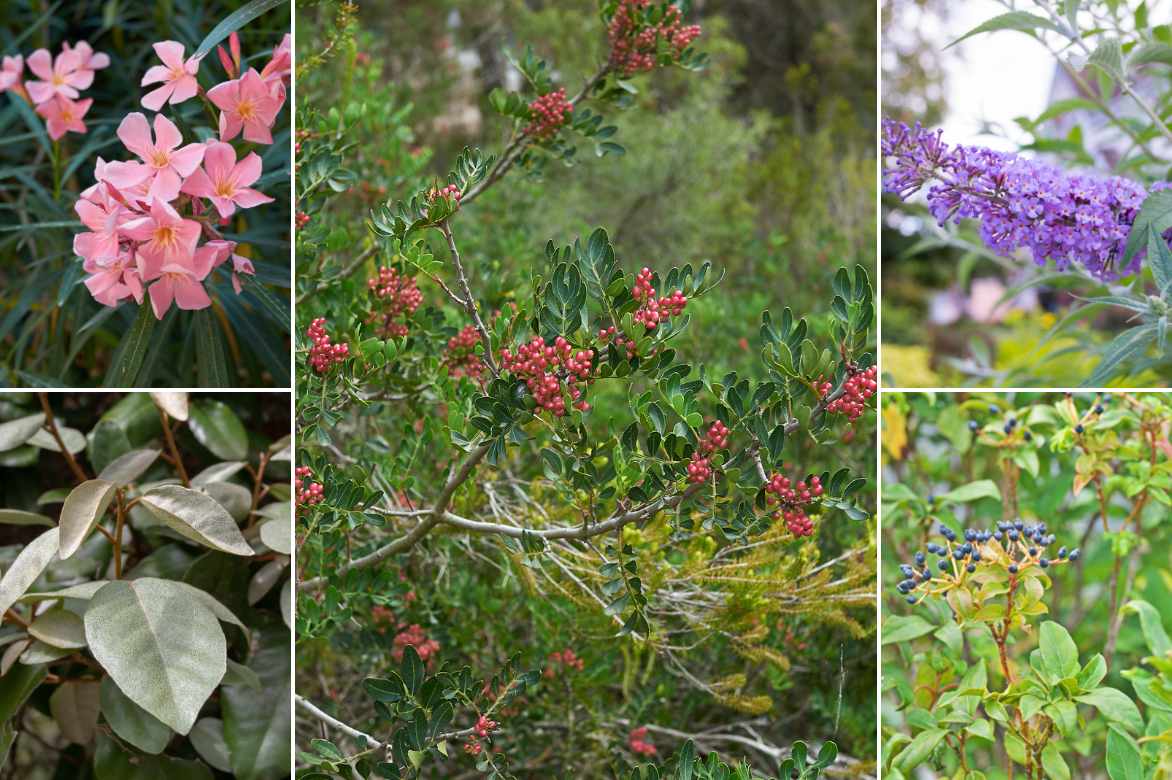
Mastic tree surrounded by oleander, Eleagnus ebbingei, Buddleia, and laurustinus (Viburnus tinus)
In a shrub bed, it thrives alongside Eucalyptus gunnii and Pittosporum. In mild climates, pair it with Olearia, Nandina, grevilleas, escallonias, or Choisya ternata.
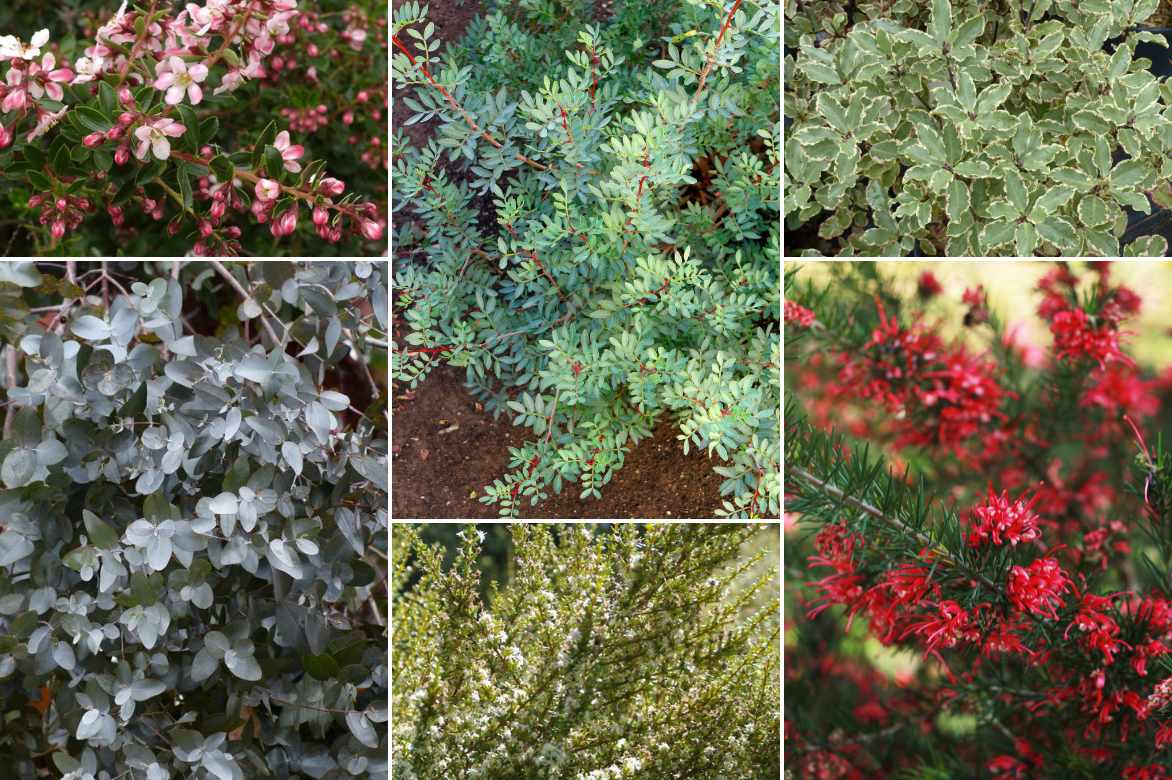
At the top centre, a mastic tree, accompanied here by an Escallonia ‘Apple Blossom’, an Eucalyptus gunnii, an Olearia solandri ‘Aurea’, a Pittosporum tenuifolium ‘Variegatum’, and a Grevillea.
Useful resources
- All our tips for growing, protecting and caring for your fruit trees are on our blog
- 13 Mediterranean fruit trees that smell like the south
- Subscribe!
- Contents































Comments